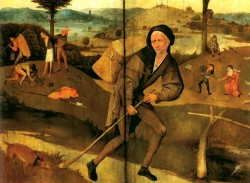
Boczkowska/Wiercinski 1981
“Hieronymus Bosch’s self-portraits” (Anna Boczkowska and Andrzej Wiercinski) 1981
[in: Ars Auro Prior – Studia Ioanni Bialostocki sexagenario dicata. Panstwowe Wydawnictwo Naukowe, Warszawa, 1981, pp. 193-199]
[Not mentioned in Gibson 1983]
By means of a (on the whole rather obtuse) comparative anthropometric analysis the authors have studied three supposed Bosch portraits and twelve faces of figures in Bosch paintings. Their conclusion is that the Bosch portrait in the Recueil d’Arras is very unreliable, whereas the pedlars (called ‘wanderers’ by the authors) in the Rotterdam tondo and in the exterior panels of the Haywain triptych (Madrid) are self-portraits.
This conclusion is not wholly improbable but of course very debatable, because the authors assume that the Bosch portrait in Amherst and the Bosch portrait in the sixteenth-century book of Domenicus Lampsonius are authentic and reliable. The truth is that we cannot know this for certain, resulting in the fact that the recognition of self-portraits in the art of Bosch is always a risky business.
The authors also refer to an astrological miniature from the Pierpont Morgan Library that is said to be the prototype of Bosch’s pedlars in Rotterdam and Madrid. Each of the three visual sources represents a poor tramp, a tree and a bull. Bosch’s pedlars are also related to the paradigma ‘a man at the crossroads’ (focusing on the choice between good and evil and often represented by the letter Y). In the Rotterdam tondo the tree has a Y-shaped bifurcation dividing the panel in a negative and a positive half. The closed gate and the bull prevent the pedlar from taking the good path. The pedlar’s tragic face does not express the refusal, but the impossibility to do good.
In the exterior panels of the Haywain we also see a Y-shaped tree and a Y-shaped branch supporting a stick that helps people cross a bridge. The bridge across the stream signals ‘inner revival and redemption’, and this means that – as opposed to the hardened sinners in the central panel – salvation is possible for the protagonist, a ‘wanderer’ whose face is that of Bosch himself.
The authors seem to have forgotten that the similar ‘wanderer’ who is the protagonist of the Rotterdam tondo can nót hope for salvation and yet he is also supposed to be Bosch himself. Furthermore, the similarity between the astrological miniature and Bosch’s pedlars is minimal, not to say negligible. And is the bovine animal really a bull? After these remarks it will be agreed that this Polish article makes a very weak impression.
[explicit 6th August 2011]